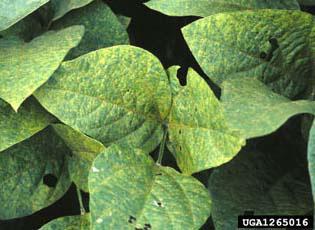Phakopsora pachyrhizi, Phakopsora meibomiae (CABI)
Soybean rust
P. pachyrhizi first appeared in Asia (Schnepf 2005); P. meibomiae is native to South and Central America and the Caribbean (Frederick et al. 2002)
P. pachyrhizi was first discovered in Hawaii in 1994, and in the continental U.S. in 2004; P. meibomiae was discovered in Puerto Rico in 1976 (Bonde et al. 2006)
P. pachyrhizi is thought to have been carried by wind to the U.S. from South America during the 2004 hurricane season (Schnepf 2005)
Disease of soybean and other legumes; P. pachyrhizi can reduce soybean yields up to 80% (Schnepf 2005); P. meibomiae is less virulent but has a broader host range (CABI)

Soybean rust damage that appears on upper leaves of soybean plants when advanced.
Reid Frederick USDA, Agricultural Research Service
Find more images
Distribution / Maps / Survey Status
Videos
All Resources
Selected Resources
The section below contains highly relevant resources for this species, organized by source.
Partnership
Federal Government
International Government
State and Local Government
Academic
Professional
Bonde, M.R., S.E. Nester, C.N. Austin, C.L. Stone, and R.D. Frederick. 2006. Evaluation of virulence of Phakopsora pachyrhizi and P. meibomiae isolates. Plant Disease 90(6):708-716.
CABI. Invasive Species Compendium. Phakopsora meibomiae. CAB International. [Accessed Sep 25, 2023].
CABI. Invasive Species Compendium. Phakopsora pachyrhizi. CAB International. [Accessed Sep 25, 2023].
Frederick, R.D., C.L. Snyder, G.L. Peterson, and M.R. Bonde. 2002. Polymerase chain reaction assays for the detection and discrimination of the soybean rust pathogens Phakopsora pachyrhizi and P. meibomiae. Phytopathology 92(2):217-227.
Schnepf, R. 2005. Asian Soybean Rust: Background and Issues [PDF, 70 KB]. (CRS Report for Congress RL32225). Congressional Research Service.
